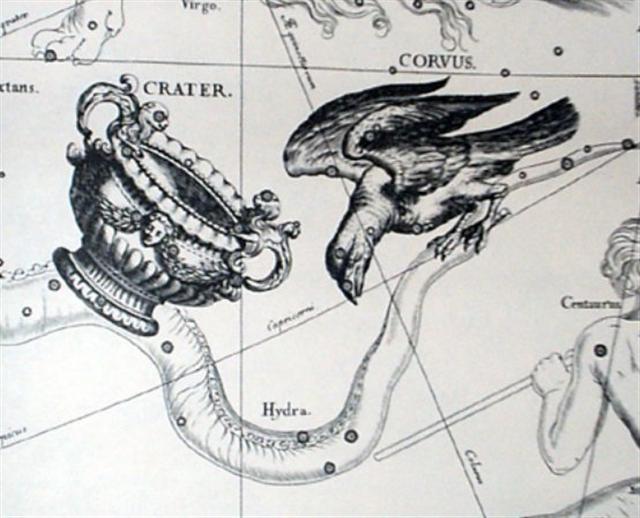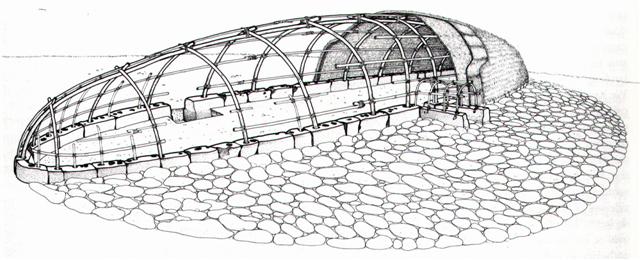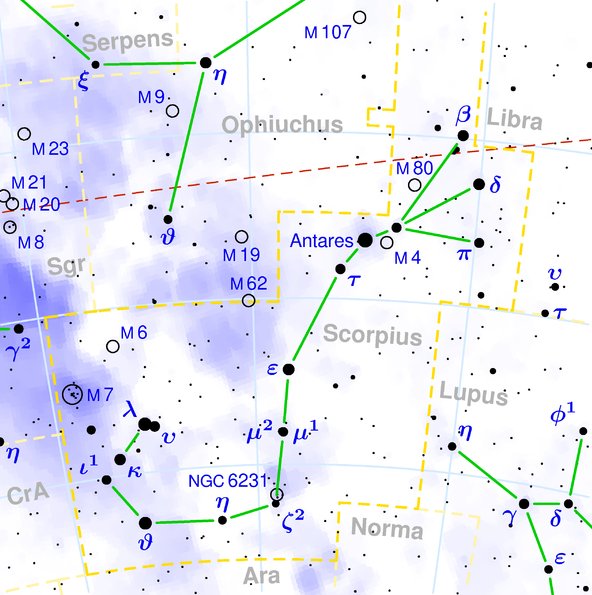Once again. Spica, the star in the middle (ki roto), was not placed in the middle of the K text. Instead it was Sirius rising at the empty vessel (Crater) in JUNE 30, which had been placed in the middle between side a and side b:
The distance from Aldebaran to Alkes was *165 - *68 = 97 days and therefore it became necessary for me to slightly adjust the position of Aldebaran in the K text accordingly. We have to count not only the glyphs but also the vacant glyph spaces. Thus there were probably 7 + 92 + 2 = 101 days on side a of the K tablet. As always Sirius rose with the Sun at the end of the first half of the year. Its position was 101 days after 0h. On the G tablet its position was at glyph 101. On the K tablet, however, the position of Sirius was at glyph 98. Why? This 3-day difference could possibly be due to Altair and the manipulations of Gregory XIII: ... So the shift in the date of the equinox that occurred between the 4th and the 16th centuries was annulled with the Gregorian calendar, but nothing was done for the first four centuries of the Julian calendar ...
... Then he thought of seeking them in the realm of Death, Tuonela, but in vain. He escaped back to the world of the living only thanks to his potent magic. He was still missing his three runes. He was then told by a shepherd to search in the mouth of Antero Vipunen, the giant ogre. The road, he was told, went over swords and sharpened axes. Ilmarinen made shoes, shirt and gloves of iron for him, but warned him that he would find the great Vipunen dead. Nevertheless, the hero went. The giant lay underground, and trees grew over his head. Vainamoinen found his way to the giant's mouth, and planted his iron staff in it. The giant awoke and suddenly opened his huge mouth. Vainamoinen slipped into it and was swallowed. As soon as he reached the enormous stomach, he thought of getting out. He built himself a raft and floated on it up and down inside the giant. The giant felt tickled and told him in many and no uncertain words where he might go, but he did not yield any runes. Then Vainamoinen built a smithy and began to hammer his iron on an anvil, torturing the entrails of Vipunen, who howled out magic songs to curse him away. But Vainamoinen said, thank you, he was very comfortable and would not go unless he got the secret words. Then Vipunen at last unlocked the treasure of his powerful runes. Many days and nights he sang, and the sun and the moon and the waves of the sea and the waterfalls stood still to hear him. Vainamoinen treasured them all and finally agreed to come out. Vipunen opened his great jaws, and the hero issued forth to go and build his boat at last ... Gregory XIII defined ºMarch 21 to be at a position 3 days earlier than what anciently had been found out from the stars. He did not correct the Julian calendar for the first few centuries. Therefore the stars were apparently pushed 3 days ahead and away from their ancient prop(p)er positions in the star calendar. Therefore the named stars Altair and Adhil were no longer in their correct calendar positions, and τ Aquilae and υ Andromedae had been forced to take their places. The Gregorian calendar was not properly aligned with the stars, his calendar was not straight but 'crooked': ... There is a couple residing in one place named Kui and Fakataka. After the couple stay together for a while Fakataka is pregnant. So they go away because they wish to go to another place - they go. The canoe goes and goes, the wind roars, the sea churns, the canoe sinks. Kui expires while Fakataka swims. Fakataka swims and swims, reaching another land. She goes there and stays on the upraised reef in the freshwater pools on the reef, and there delivers her child, a boy child. She gives him the name Taetagaloa. When the baby is born a golden plover flies over and alights upon the reef. (Kua fanau lā te pepe kae lele mai te tuli oi tū mai i te papa). And so the woman thus names various parts of the child beginning with the name 'the plover' (tuli): neck (tuliulu), elbow (tulilima), knee (tulivae). They go inland at the land. The child nursed and tended grows up, is able to go and play. Each day he now goes off a bit further away, moving some distance away from the house, and then returns to their house. So it goes on and the child is fully grown and goes to play far away from the place where they live. He goes over to where some work is being done by a father and son. Likāvaka is the name of the father - a canoe-builder, while his son is Kiukava. Taetagaloa goes right over there and steps forward to the stern of the canoe saying - his words are these: 'The canoe is crooked.' (kalo ki ama). Instantly Likāvaka is enraged at the words of the child. Likāvaka says: 'Who the hell are you to come and tell me that the canoe is crooked?' Taetagaloa replies: 'Come and stand over here and see that the canoe is crooked.' Likāvaka goes over and stands right at the place Taetagaloa told him to at the stern of the canoe. Looking forward, Taetagaloa is right, the canoe is crooked. He slices through all the lashings of the canoe to straighten the timbers. He realigns the timbers. First he must again position the supports, then place the timbers correctly in them, but Kuikava the son of Likāvaka goes over and stands upon one support. His father Likāvaka rushes right over and strikes his son Kuikava with his adze. Thus Kuikava dies. Taetagaloa goes over at once and brings the son of Likāvaka, Kuikava, back to life. Then he again aligns the supports correctly and helps Likāvaka in building the canoe. Working working it is finished ...
Possibly Gregory XIII wished to have a correction of the ancient star position pattern because the distance from Aldebaran to Antares had increased to 181 days, with around 3 days since the time of Taurus:
Let's look at the situation anew. At the time of Gregory XIII there were 84 days from Alkes (*161) to Antares (*245):
I had estimated *95 glyphs for side b on the K tablet. Line Kb5 should have room for 20 glyphs and Antares could have been at the empty glyph space at the beginning of line Kb5. Counting backwards from my total *192 (or rather *193 because of the missing glyph at Alkes) the beginning of line Kb5 could have represented SEPTEMBER 22 (equinox). 265 (SEPTEMBER 22) + 64 = 329 (November 25). At the time of Gregory XIII heliacal Antares would have been in day 329 - 4 = 325 (nicely arranged to be the year for his highly valued Council of Nicaea). ... When Julius Caesar established his calendar in 45 BC he set March 25 as the spring equinox. Since a Julian year (365.25 days) is slightly longer than an actual year the calendar drifted with respect to the equinox, such that the equinox was occurring on about 21 March in AD 300 and by AD 1500 it had reached 11 March. This drift induced Pope Gregory XIII to create a modern Gregorian calendar. The Pope wanted to restore the edicts concerning the date of Easter of the Council of Nicaea of AD 325 ... However, when counting glyphs from Kb1-1 to *Kb5-1 we will find the distance to be 22 + 18 + 16 + 19 = 75 (not 84).
Therefore it was probably not Antares but Vrischika (π Scorpii) which had been placed at the beginning of line Kb5.
... Early India knew it [Scorpius] as Āli, Viçrika, or Vrouchicam, - in Tamil, Vrishaman; but later on Varāha Mihira said Kaurpya, and Al Birūni, Kaurba, both from the Greek Scorpios. On the Cingalese zodiac it was Ussika ... ... In the legends of the Polynesian Islanders, notably those of the Hervey group, the stars in the Scorpion, from the two lettered μ to λ and υ [i.e., with a pair of stars at both ends], were the Fish-hook of Maui, with which that god drew up from the depths the great island Tongareva ... |
|||||||||||||||||||||||||||||||||||||||||||||||||||||||||||||||||||||||||||||||||||||||||||||||||||||||||||||||||||||||||||||||||||||||||||||||||||||||||||||||||||||||||||||||||||||||||||||||||||||||||||||||||||||||||||||||||||||||||||||||||||||||||||||||||||||||||||||||||||||||||||||||||||||||||||||||||||||||||||||||||||||||||||||||||||||||||||||||||||||||||||||||||||||||||||||||||||||||||||||||||||||||||||||||||||||||||||||||||||||||||||||||||||||||||||


















